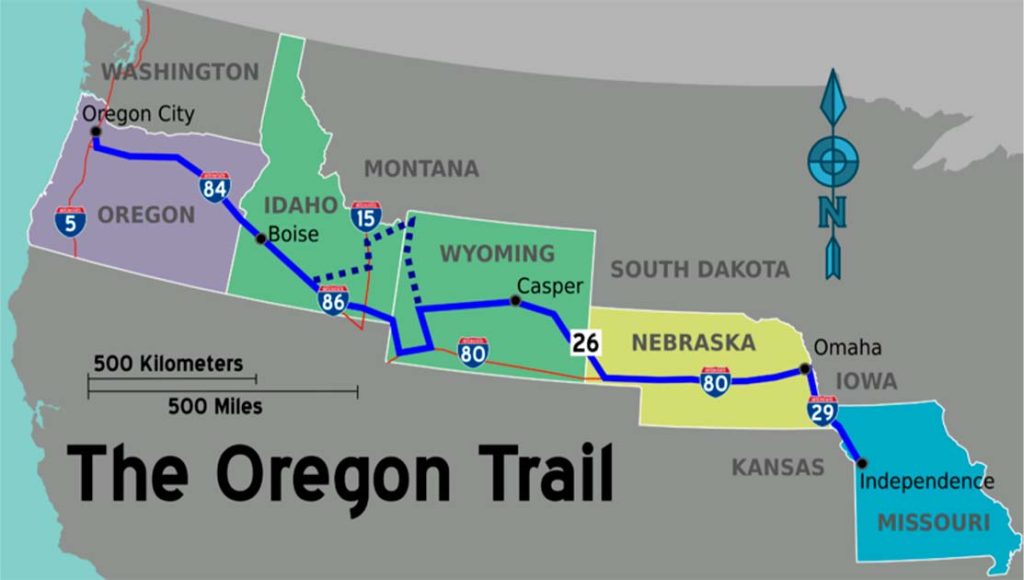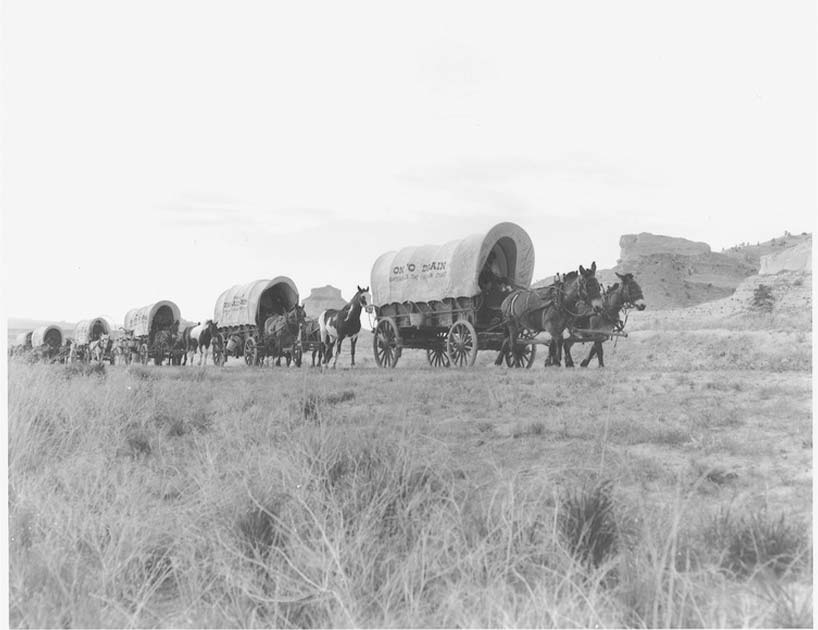Want to know how the west was won? There were battles and there were cowboys, but it truth it came from mass migration. Incentivized by the government and a huge risk for anyone who undertook it, the Oregon Trail made the United States of America.
This 3,490 kilometers (2,170 miles) trail ran from east to west across the continental United States. It was primarily run as an emigrant trail and was often covered by large-wheeled wagons.
It ran through many of the central and southern states. From connecting the valleys of the Oregon to the Missouri River, the eastern section of the Oregon Trail stretched through what is now Kansas and pretty much all of Nebraska and Wyoming.
The western half on the other hand spanned much of Oregon and Idaho. Its origin lay in fur trappers and traders in the 19th century. Throughout this century, the Oregon Trail was used by around 400,000 settlers of the American country to help colonize and settle it.
History
The Oregon Trail history begins in 1803 when President Jefferson instructed Meriwether Lewis to explore the Missouri River and how it communicated with the Pacific Ocean through the states of Colombia, Oregon, and Colorado. The first land route across the United States was mapped by Lewis and his partner William Clark between 1804 and 1806.

They believed that they would be able to find a practical overland route to the West Coast. In their expedition, they found two passes that went through the Rocky Mountains but were too difficult for schooner wagons to go through without significant infrastructure being in place.
However they were undeterred, and soon their hard work would be rewarded. They found another pass, which would later be named the Lewis and Clark Pass, and which led to the Missouri River. It was shorter and faster than previous proposed routes, though had its roads controlled by Native American tribes.
- Moncacht-Apé: Did this Yazoo Conquer the Wild West First?
- Lasseter’s Reef and the Lost Gold of Australia
The expedition of Lewis and Clark had however not found the route that Jefferson had sent them out for. They had come to the conclusion that there was no easy route through the mountains.
Regardless, they were able to map the western and eastern river valleys that would act as the Oregon Trail across the continental divide. What they missed was the South Pass, which would be key for the Oregon Trail.
The Fur Company
The Pacific Fur Company operated in the Pacific Northwest. In 1810, there were two movements which were planned. One was going over the sea across the Columbia River whilst the other was going overland and it was led by Wilson Price Hunt.
This party was expected to find new supply routes and trapping territories for fur trading posts. However, due to the fact that the nearby Niitsitapi tribe was threatening them, Hunt and his party went further south than the route that Lewis and Clark had taken years before. They managed to find that much of the route along the Snake River plain and across into Columbia was passable by pack trains and wagons.
After this, the Pacific Fur Company hoped to retrace the path of the expedition. However, fears of attack forced the group to go further south again which led them to discover the South Pass which was a wide and easy access to the Continental Divide. It had the practical ability to be used for wagons, but it was not used for more than 10 years due to the War of 1812.
The Creation of the Trail
The Oregon Trail was largely dictated by its topography and climate. Access to a water supply was vital on long journeys across the American desert and for much of the trail’s route, it followed the region’s great rivers, the Platte, the Snake, and the Columbia. Safe passages were made through and around the mountain ranges. The most important of these was the South Pass.

The grass was ample on the prairies of the trail and whilst the lands that bordered it were heavily populated with bison and livestock brought by the emigrants, and it provided sustenance for those who used it. Western Nebraska was the beginning of sagebrush, a shrub essential for many species, vegetation that stretched across the land. The Bear River in eastern Idaho was pleasantly green and the Grande Ronde River in North-eastern Oregon showed a completely different view.
The winter of 1842 brought Marcus Whitman to Boston. Marcus Whitman had taken the Oregon Train to the Willamette Valley. His party was led by a man named Bonneville. During the journey, the Whitman group became the first people to make the journey on the trail using wagons.
- The Oregon Meteorite Mystery: Was the Port Orford Incident a Hoax?
- The Solutrean Hypothesis: Did France Colonize the US 20,000 years ago?
When he arrived in Willamette Valley, Marcus established a mission that was visited often by emigrants on their way west. Back in 1842, when Marcus returned from his trip to Boston, he stopped at Independence where many immigrants had gathered to make the journey west.
This wagon train would be the first large migration across the Oregon Trail and as such was named the Great Migration. It was around 120 wagons and was made up of around 1,000 people.

Following the Great Migration, emigration to Oregon increased and the United States began to take more and more control of the Oregon territory. Many of its supporters used the slogan “54 degrees 40 minutes or fight” as the northern boundary of Oregon was on the latitude line of 54 degrees 40 minutes.
President Polk was a firm supporter of the ideology of America’s manifest destiny and made a proposition to British officials to establish a boundary along the Oregon Trail. This was worked on by the Secretary of State and Senator John C. Calhoun of South Carolina alongside the British officials.
This culminated in the Oregon Treaty of 1846. It stated that all of Vancouver Island was given to Canada and the US was given the lower portion of the territory. Thousands of Americans would use the Oregon Trail over the next 30-odd years.
Legacy
The Oregon Trail is regarded as one of the most important trails to have existed in the United States. It provided a path for westward expansion across the US.
It was used by thousands of people in the 19th century. The trail played a vital role in the settlement and development of the American West and represented the ideology that had swept the nation known as manifest destiny. It has inspired many creative works and has even been represented in video games and many tv shows.
Top Image: Dangerous in any number of ways, the Oregon Trail was still a route for settlers to travel west. Source: Bureau of Land Management / Public Domain.
By Kurt Readman